[English] 日本語
 Yorodumi
Yorodumi- PDB-4ifq: Crystal structure of Saccharomyces cerevisiae NUP192, residues 2 ... -
+ Open data
Open data
- Basic information
Basic information
| Entry | Database: PDB / ID: 4ifq | ||||||
|---|---|---|---|---|---|---|---|
| Title | Crystal structure of Saccharomyces cerevisiae NUP192, residues 2 to 960 [ScNup192(2-960)] | ||||||
 Components Components | Nucleoporin NUP192 | ||||||
 Keywords Keywords | PROTEIN TRANSPORT / Structural genomics / NYSGRC / PSI-Biology / New York Structural Genomics Research Consortium / alpha solenoid-like / Nuclear Pore Complex component / NPC / Nup192 / Nup188 / Nucleoporin / Nucleocytoplasmic Transport: a Target for Cellular Control / NPCXstals | ||||||
| Function / homology |  Function and homology information Function and homology informationnuclear pore inner ring / regulation of nucleocytoplasmic transport / nuclear pore organization / : / Regulation of HSF1-mediated heat shock response / SUMOylation of SUMOylation proteins / structural constituent of nuclear pore / SUMOylation of RNA binding proteins / SUMOylation of chromatin organization proteins / nucleocytoplasmic transport ...nuclear pore inner ring / regulation of nucleocytoplasmic transport / nuclear pore organization / : / Regulation of HSF1-mediated heat shock response / SUMOylation of SUMOylation proteins / structural constituent of nuclear pore / SUMOylation of RNA binding proteins / SUMOylation of chromatin organization proteins / nucleocytoplasmic transport / mRNA transport / nuclear pore / nuclear envelope / protein transport / nucleus Similarity search - Function | ||||||
| Biological species |  | ||||||
| Method |  X-RAY DIFFRACTION / X-RAY DIFFRACTION /  SYNCHROTRON / SYNCHROTRON /  SAD / Resolution: 3.25 Å SAD / Resolution: 3.25 Å | ||||||
 Authors Authors | Sampathkumar, P. / Almo, S.C. / New York Structural Genomics Research Consortium (NYSGRC) / Nucleocytoplasmic Transport: a Target for Cellular Control (NPCXstals) | ||||||
 Citation Citation |  Journal: Structure / Year: 2013 Journal: Structure / Year: 2013Title: Structure, dynamics, evolution, and function of a major scaffold component in the nuclear pore complex. Authors: Parthasarathy Sampathkumar / Seung Joong Kim / Paula Upla / William J Rice / Jeremy Phillips / Benjamin L Timney / Ursula Pieper / Jeffrey B Bonanno / Javier Fernandez-Martinez / Zhanna ...Authors: Parthasarathy Sampathkumar / Seung Joong Kim / Paula Upla / William J Rice / Jeremy Phillips / Benjamin L Timney / Ursula Pieper / Jeffrey B Bonanno / Javier Fernandez-Martinez / Zhanna Hakhverdyan / Natalia E Ketaren / Tsutomu Matsui / Thomas M Weiss / David L Stokes / J Michael Sauder / Stephen K Burley / Andrej Sali / Michael P Rout / Steven C Almo /  Abstract: The nuclear pore complex, composed of proteins termed nucleoporins (Nups), is responsible for nucleocytoplasmic transport in eukaryotes. Nuclear pore complexes (NPCs) form an annular structure ...The nuclear pore complex, composed of proteins termed nucleoporins (Nups), is responsible for nucleocytoplasmic transport in eukaryotes. Nuclear pore complexes (NPCs) form an annular structure composed of the nuclear ring, cytoplasmic ring, a membrane ring, and two inner rings. Nup192 is a major component of the NPC's inner ring. We report the crystal structure of Saccharomyces cerevisiae Nup192 residues 2-960 [ScNup192(2-960)], which adopts an α-helical fold with three domains (i.e., D1, D2, and D3). Small angle X-ray scattering and electron microscopy (EM) studies reveal that ScNup192(2-960) could undergo long-range transition between "open" and "closed" conformations. We obtained a structural model of full-length ScNup192 based on EM, the structure of ScNup192(2-960), and homology modeling. Evolutionary analyses using the ScNup192(2-960) structure suggest that NPCs and vesicle-coating complexes are descended from a common membrane-coating ancestral complex. We show that suppression of Nup192 expression leads to compromised nuclear transport and hypothesize a role for Nup192 in modulating the permeability of the NPC central channel. | ||||||
| History |
|
- Structure visualization
Structure visualization
| Structure viewer | Molecule:  Molmil Molmil Jmol/JSmol Jmol/JSmol |
|---|
- Downloads & links
Downloads & links
- Download
Download
| PDBx/mmCIF format |  4ifq.cif.gz 4ifq.cif.gz | 188.9 KB | Display |  PDBx/mmCIF format PDBx/mmCIF format |
|---|---|---|---|---|
| PDB format |  pdb4ifq.ent.gz pdb4ifq.ent.gz | 147.8 KB | Display |  PDB format PDB format |
| PDBx/mmJSON format |  4ifq.json.gz 4ifq.json.gz | Tree view |  PDBx/mmJSON format PDBx/mmJSON format | |
| Others |  Other downloads Other downloads |
-Validation report
| Summary document |  4ifq_validation.pdf.gz 4ifq_validation.pdf.gz | 450 KB | Display |  wwPDB validaton report wwPDB validaton report |
|---|---|---|---|---|
| Full document |  4ifq_full_validation.pdf.gz 4ifq_full_validation.pdf.gz | 462 KB | Display | |
| Data in XML |  4ifq_validation.xml.gz 4ifq_validation.xml.gz | 31 KB | Display | |
| Data in CIF |  4ifq_validation.cif.gz 4ifq_validation.cif.gz | 42.3 KB | Display | |
| Arichive directory |  https://data.pdbj.org/pub/pdb/validation_reports/if/4ifq https://data.pdbj.org/pub/pdb/validation_reports/if/4ifq ftp://data.pdbj.org/pub/pdb/validation_reports/if/4ifq ftp://data.pdbj.org/pub/pdb/validation_reports/if/4ifq | HTTPS FTP |
-Related structure data
- Links
Links
- Assembly
Assembly
| Deposited unit | 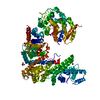
| ||||||||
|---|---|---|---|---|---|---|---|---|---|
| 1 |
| ||||||||
| 2 | 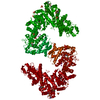
| ||||||||
| Unit cell |
| ||||||||
| Details | THE DIMERIC INTERFACE SUGGESTED BY PISA IS LIKELY TO BE NON-BIOLOGICAL |
- Components
Components
| #1: Protein | Mass: 111779.430 Da / Num. of mol.: 1 / Fragment: UNP residues 2-960 Source method: isolated from a genetically manipulated source Source: (gene. exp.)  Strain: ATCC 204508 / S288c / Gene: J1216, NUP192, YJL039C / Plasmid: pSGX3 / Production host:  | ||||||
|---|---|---|---|---|---|---|---|
| #2: Chemical | ChemComp-SO4 / #3: Chemical | ChemComp-IOD / #4: Water | ChemComp-HOH / | Has protein modification | Y | |
-Experimental details
-Experiment
| Experiment | Method:  X-RAY DIFFRACTION / Number of used crystals: 1 X-RAY DIFFRACTION / Number of used crystals: 1 |
|---|
- Sample preparation
Sample preparation
| Crystal | Density Matthews: 4.76 Å3/Da / Density % sol: 74.14 % |
|---|---|
| Crystal grow | Temperature: 298 K / Method: vapor diffusion, sitting drop Details: Protein (20 mM Hepes, pH 8.0, 500 mM NaCl, 10% glycerol, 5mM DTT; Reservoir (10% PEG3350, 100mM pottasium iodide); Cryoprotection (30% PEG400 and 25% saturated ammonium sulfate), Vapor ...Details: Protein (20 mM Hepes, pH 8.0, 500 mM NaCl, 10% glycerol, 5mM DTT; Reservoir (10% PEG3350, 100mM pottasium iodide); Cryoprotection (30% PEG400 and 25% saturated ammonium sulfate), Vapor Diffusion, Sitting Drop, temperature 298K |
-Data collection
| Diffraction | Mean temperature: 100 K |
|---|---|
| Diffraction source | Source:  SYNCHROTRON / Site: SYNCHROTRON / Site:  NSLS NSLS  / Beamline: X29A / Wavelength: 0.9792 Å / Beamline: X29A / Wavelength: 0.9792 Å |
| Detector | Type: ADSC QUANTUM 315 / Detector: CCD / Date: Mar 15, 2012 / Details: MIRRORS |
| Radiation | Monochromator: Si(111) / Protocol: SINGLE WAVELENGTH / Monochromatic (M) / Laue (L): M / Scattering type: x-ray |
| Radiation wavelength | Wavelength: 0.9792 Å / Relative weight: 1 |
| Reflection | Resolution: 3.254→50 Å / Num. all: 64698 / Num. obs: 64698 / % possible obs: 100 % / Observed criterion σ(I): 0 / Redundancy: 8.4 % / Biso Wilson estimate: 78 Å2 / Rsym value: 0.136 / Net I/σ(I): 17.5 |
| Reflection shell | Resolution: 3.25→3.29 Å / Redundancy: 8.4 % / Mean I/σ(I) obs: 2.6 / Num. unique all: 2186 / Rsym value: 0.969 / % possible all: 100 |
- Processing
Processing
| Software |
| ||||||||||||||||||||||||||||||||||||||||||||||||||||||||||||
|---|---|---|---|---|---|---|---|---|---|---|---|---|---|---|---|---|---|---|---|---|---|---|---|---|---|---|---|---|---|---|---|---|---|---|---|---|---|---|---|---|---|---|---|---|---|---|---|---|---|---|---|---|---|---|---|---|---|---|---|---|---|
| Refinement | Method to determine structure:  SAD SADStarting model: Built using AutoBuild (Phenix) and Buccaneer (CCP4) Resolution: 3.25→47.76 Å / Cor.coef. Fo:Fc: 0.944 / Cor.coef. Fo:Fc free: 0.91 / Occupancy max: 1 / Occupancy min: 0.45 / SU B: 15.519 / SU ML: 0.253 / Cross valid method: THROUGHOUT / σ(F): 0 / ESU R: 0.753 / ESU R Free: 0.373 / Stereochemistry target values: MAXIMUM LIKELIHOOD Details: HYDROGENS HAVE BEEN ADDED IN THE RIDING POSITIONS U VALUES : REFINED INDIVIDUALLY
| ||||||||||||||||||||||||||||||||||||||||||||||||||||||||||||
| Solvent computation | Ion probe radii: 0.8 Å / Shrinkage radii: 0.8 Å / VDW probe radii: 1.2 Å / Solvent model: BABINET MODEL WITH MASK | ||||||||||||||||||||||||||||||||||||||||||||||||||||||||||||
| Displacement parameters | Biso max: 184.54 Å2 / Biso mean: 85.2254 Å2 / Biso min: 41.66 Å2
| ||||||||||||||||||||||||||||||||||||||||||||||||||||||||||||
| Refinement step | Cycle: LAST / Resolution: 3.25→47.76 Å
| ||||||||||||||||||||||||||||||||||||||||||||||||||||||||||||
| Refine LS restraints |
| ||||||||||||||||||||||||||||||||||||||||||||||||||||||||||||
| LS refinement shell | Resolution: 3.254→3.338 Å / Total num. of bins used: 20
|
 Movie
Movie Controller
Controller



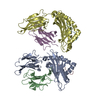

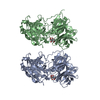

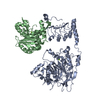
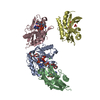
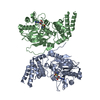

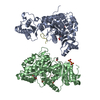

 PDBj
PDBj





